State of Nebraska Heating Oil and Propane Program (SHOPP)
SHOPP 2024/2025 Highlights
The month of October was 40 percent warmer than normal October winter weather.
Residential propane prices averaged two percent higher than the last heating season (2023/2024).
Propane stocks were at 375,000 barrels at the beginning of the heating season (October 2024). The 375,000-barrel level was in the center of the five-year range.
Propane stocks ended the season (March 2025) in the lower half of the five-year range.
Residential heating oil prices averaged 16 percent lower than the last winter season (2023/2024).
Distillate fuel stocks started the heating season (October 2024) at 525,000 barrels, which was in the lower half of the five-year range.
Distillate fuel stocks ended the season (March 2025) in the center of the five-year range.
Winter Recap
The winter of 2024/2025 in Nebraska was 6.5 percent warmer than normal, indicating fewer cold days than usual. Weather is always the wild card in the winter season. (Figure 1--right-click and choose "Open image in new tab".) Along with weather, other variables that affected prices and supply in the U.S. included OPEC+ issues, geopolitical incidents, refinery matters, and union strikes. There are more variables but not all are mentioned in this report.
In October 2024, the dockworkers' union (the International Longshoremen's Association) suspended a three-day strike until January 15, 2025. The workers went back to work immediately. The surprise end to the strike might have caught railroads with cars, engines, and crews out of position, but it was thought that railroads were likely to work quickly to fix that. Supply chain experts said consumers wouldn't see an immediate impact from the strike because most retailers stocked up on goods, moving ahead shipments of holiday gift items.
In October 2024, a rise in oil prices intensified after President Biden suggested that U.S. officials were considering whether to support an Israeli strike on Iranian oil facilities, a move that would have pushed gasoline prices higher just weeks before the presidential election. A calm 2024 for petroleum gave way to bets that a spike in energy prices would follow. Benchmark U.S. crude jumped 5.1 percent, to $73.71, its largest one-day gain since the early stages of Israel's war on Hamas a year ago. The tremors weighed down U.S. stock indexes and left investors scrambling to understand the potential fallout of a broader war.
Also in October 2024, Saudi Arabia's oil minister warned of oil prices as low as $50 per barrel as OPEC+ members openly disregarded production curbs. OPEC+ wasn't sticking to agreed-upon production limits. The kingdom called out members for overproducing, in what was seen as a veiled threat of a price war. Saudi Arabia was willing to launch the price war to keep its market share. With this threat, OPEC+ producers agreed to output cuts.
At the end of October 2024, crude oil prices fell after Israel's strike on Iran steered clear of Iran's oil and nuclear facilities. Oil futures fell toward some of their lowest prices in years after Israel's strikes on Iran avoided energy facilities and reduced the fears of a wider war that could have disrupted global supplies.
Figure 11 (right-click and choose "Open image in new tab") shows the five-year range, the five-year average, and last year's distillate inventory levels for Nebraska. Inventories were in the lower half of the five-year range at the beginning and at the end of the winter season (October and March). Likewise, inventories were below the five-year average and last year's levels in these two months. The inventory levels stayed above the five-year range for November, December, and January. In February, the inventory level was at the upper boundary. The inventory levels were above the five-year average and last year's levels in these months with the exception of January. In January, the level was equal to January 2024's level.
Throughout the winter heating season, the weekly average retail prices of home heating oil in Nebraska were in the center of the five-year range, much lower than last year's prices, and equivalent to the five-year averages.
Nebraska’s propane inventory levels were relatively volatile this winter. Levels started the season in the upper half of the five-year range similar to the last four years. Inventories increased to the upper boundary in December, dropped to the lower boundary in January, were in the center in February, and fell slightly to the lower half of the five-year range in March.
The prices of propane were flat and equivalent to the five-year averages and last year's prices throughout the heating season. The prices were in the center of the five-year range for all six months.
Residential Propane
The average home heating charge price for delivery of consumer-grade propane, excluding taxes and cash discounts, in Nebraska for the 2024/2025 heating season was $1.66 per gallon. This was a three-cent (or two-percent) increase from last season's average price at $1.63. Propane prices are subject to both the volatility of the oil markets and natural gas production.
For the 2024/2025 season, the average retail price of propane started at $1.58 per gallon. The average price was stable throughout the season even with an increase in January. Prices during both the 2023/2024 and 2024/2025 seasons were equivalent. The fifth week of March, or the end of the season, had a price of $1.74 per gallon. This price was 16 cents higher than the price at the beginning of the heating season. (See Figures 2 and 5. Right-click and choose "Open image in new tab".)
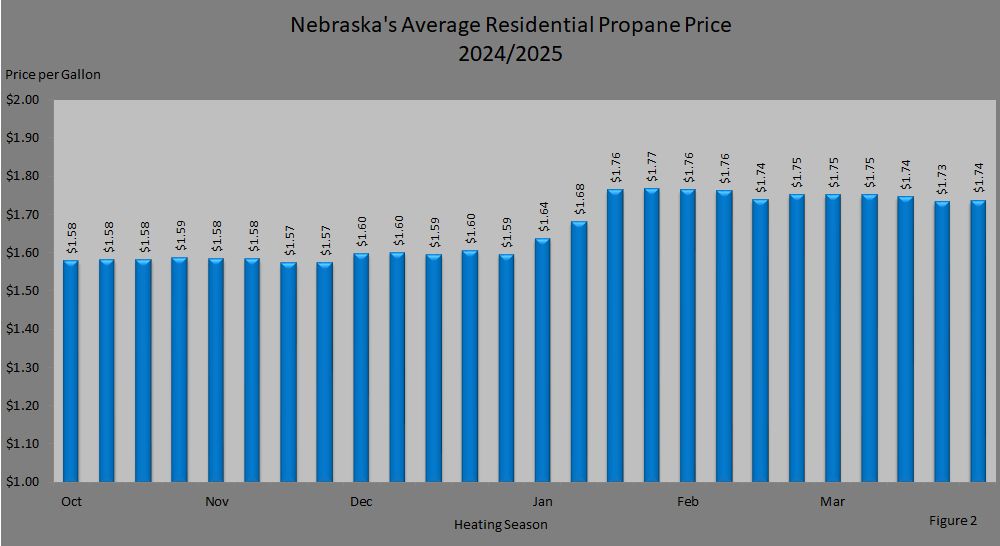
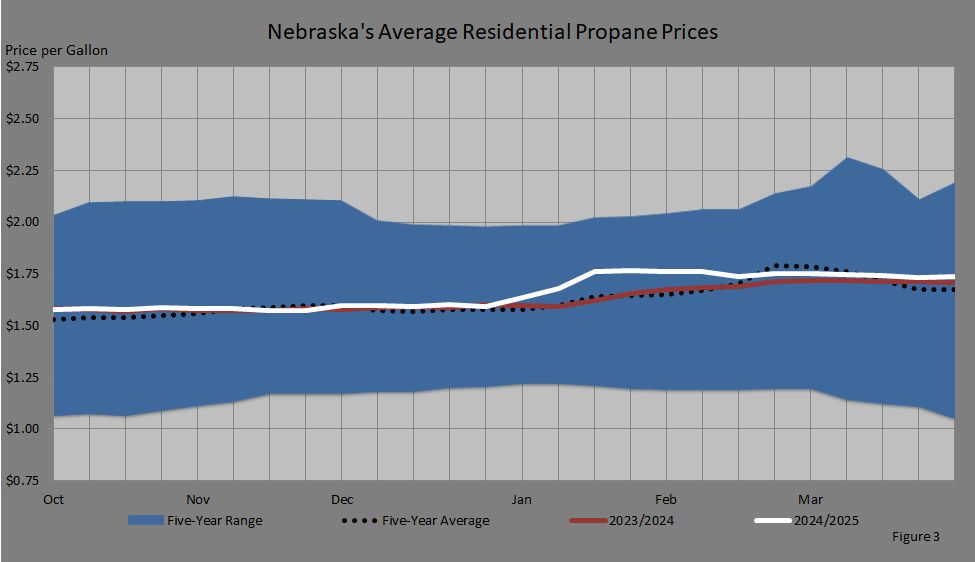
As was stated in the last paragraph, the average propane price began the 2024/2025 heating season at $1.58, the same price at the beginning of the last heating season. As shown in Figure 3 (right-click and choose "Open image in new tab"), with the exception of January, the average propane prices in the 2024/2025 season were stable remaining in the center of the five-year range and relatively equivalent to the five-year average and last year's prices.
The average wholesale propane price began the 2024/2025 heating season at 89 cents, which was eight cents higher than the price of 81 cents at the beginning of the last heating season. As Figure 4 shows (right-click and choose "Open image in new tab"), with the exception of January, average wholesale propane prices were relatively stable while staying in the center of the five-year range, above and below the five-year average, and above last year's prices. The wholesale price ended the season at 95 cents which was six cents above the price at the beginning of the season (89 cents).
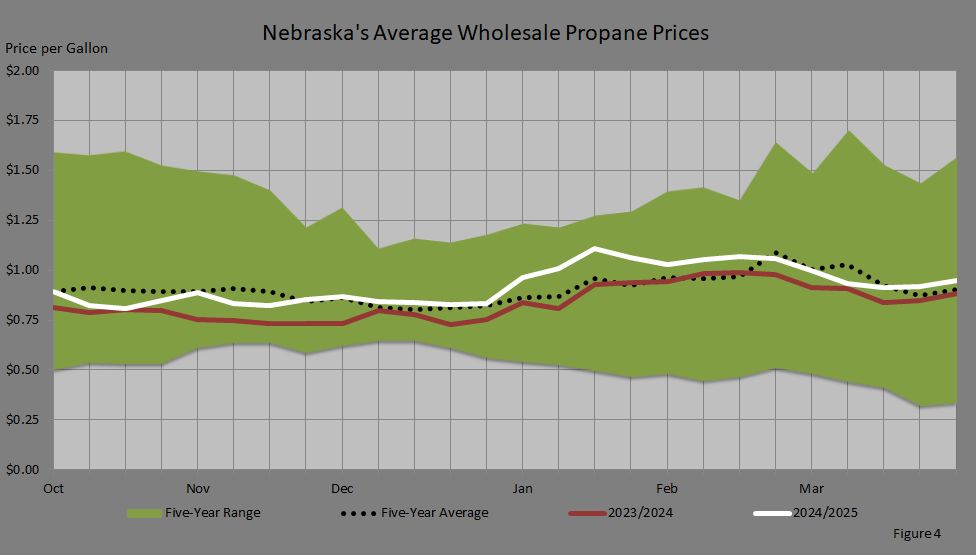
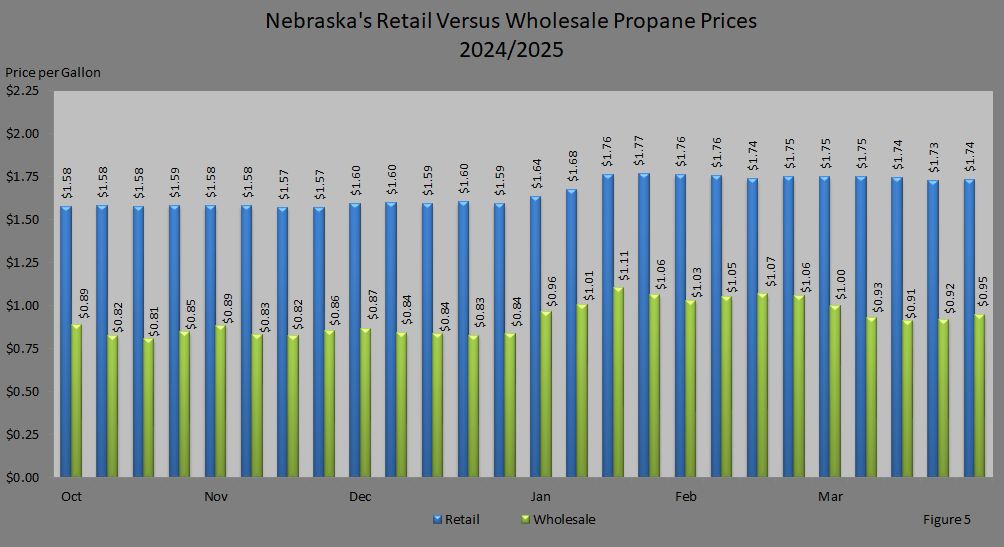
A comparison of average retail propane prices versus average wholesale propane prices in Figure 5 shows that retail prices during the 2024/2025 heating season ranged from a low of $1.57 to a high of $1.77, while wholesale prices ranged from a low of 81 cents to a high of $1.11. Retail prices increased in January and stayed at that level to the end of the season. Wholesale prices were less stable throughout the season. (See Figure 5 by a right-click and choosing "Open image in new tab".)
According to EIA, Nebraska's total inventory of propane was 375,000 barrels at the beginning of the heating season in October 2024, which was 7,000 barrels (1.8 percent) below propane stocks one year earlier. Stocks started the season in the center of the five-year range, reached the upper boundary in December and fell to the lower boundary in January (due to increased heating degree days during the blizzard on January 5 and 6, 2025), moved to the center of the five-year range in February, and fell to the lower half of the five-year range in March. Stocks ended the heating season at 78,000 barrels which was 67 percent less than the end of last year's season. (Figure 6) (Right-click on Figure 6 and choose "Open image in new tab".) Nebraska experienced a one-day blizzard on March 19, 2025. In Figure 1 (right-click and choose "Open image in new tab".), heating degree days show a drop in March probably due to the blizzard being one day.
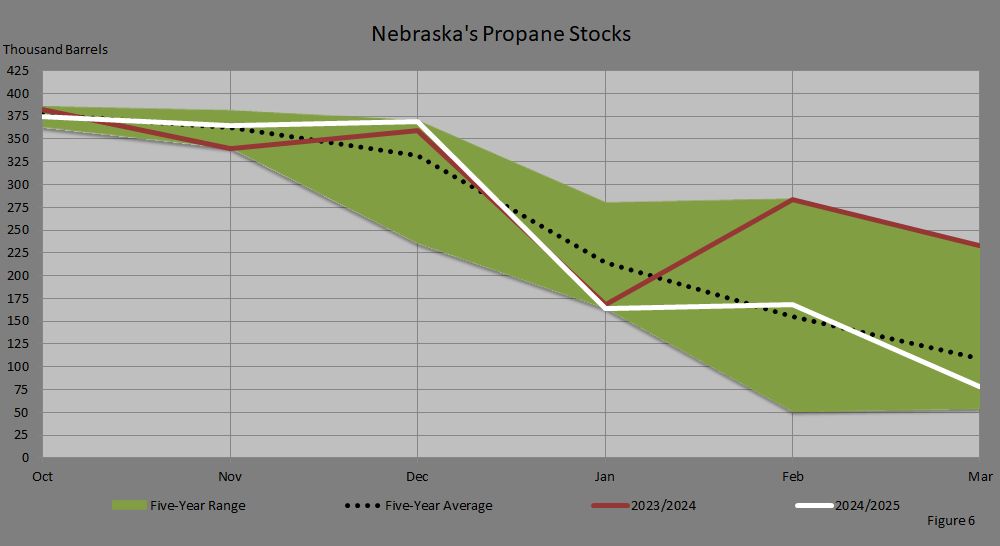
Residential Heating Oil
The average home heating price for delivery of No. 2 heating oil, excluding taxes and cash discounts, in Nebraska for the 2024/2025 heating season was $2.76 per gallon. The season's average price dropped 53 cents (or 16 percent) from last season's average of $3.29. Heating oil prices are highly dependent on crude oil market movements.
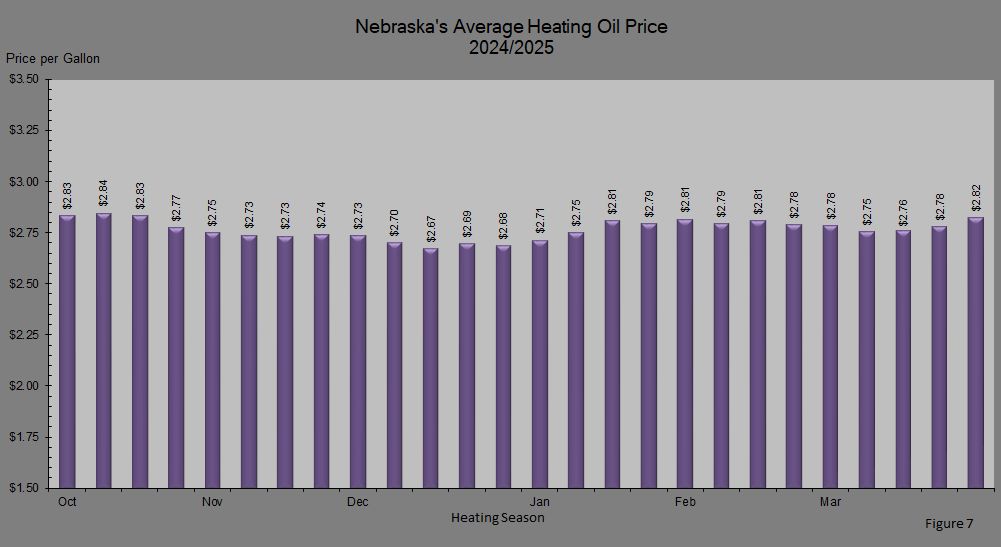
Figure 7 (right-click and choose "Open image in new tab") shows that the average retail price of heating oil started the 2024/2025 season at $2.83 per gallon, $1.02 (27 percent) lower than the price of $3.85 at the beginning of the last heating season. Average heating oil prices were stable throughout the season. The ending price of $2.82 per gallon was one cent (less than one percent) lower than the price at the beginning of the season ($2.83).
As Figure 8 shows (right-click and choose "Open image in new tab"), the average price of heating oil was considerably lower than last year's price. The price was seven cents lower than the five-year average at the beginning of the heating season. The average price started in the center of the five-year range and continued in the center throughout the season.
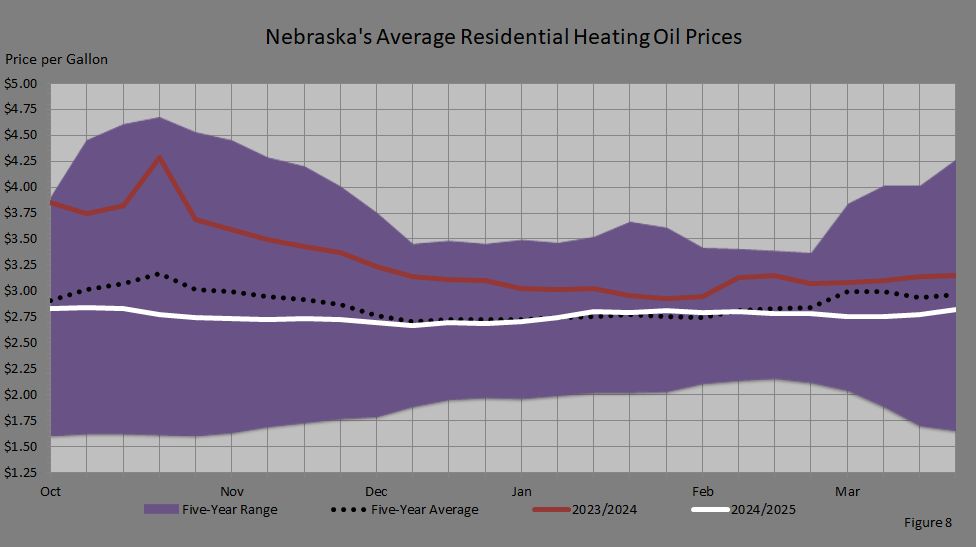
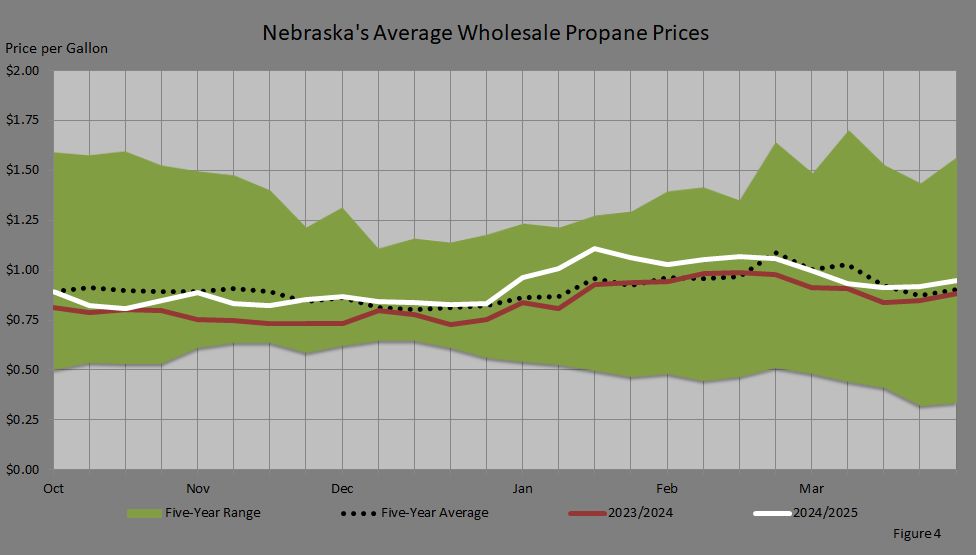
The average wholesale heating oil price began the 2024/2025 heating season at $2.48 per gallon, $1.02 (29 percent) lower than the price of $3.50 at the beginning of the last heating season. Average wholesale heating oil prices were relatively stable this winter.
As Figure 9 shows (right-click and choose "Open image in new tab"), prices were equivalent to the five-year average the entire heating season.
The average wholesale prices were at the center of the five-year range throughout the season.
The average wholesale price of heating oil started the season $1.03 lower than last year's price. Prices were below last year's prices until the last three weeks of January when the price was equivalent to last year's price. At the end of the heating season, the price was 29 cents below last year's price.
A comparison of retail heating oil prices and wholesale heating oil prices in Figure 10 (right-click and choose "Open image in new tab") shows that, during the 2024/2025 heating season, retail prices ranged from a low of $2.67 to a high of $2.84, while wholesale prices ranged from a low of $2.10 to a high of $2.48.
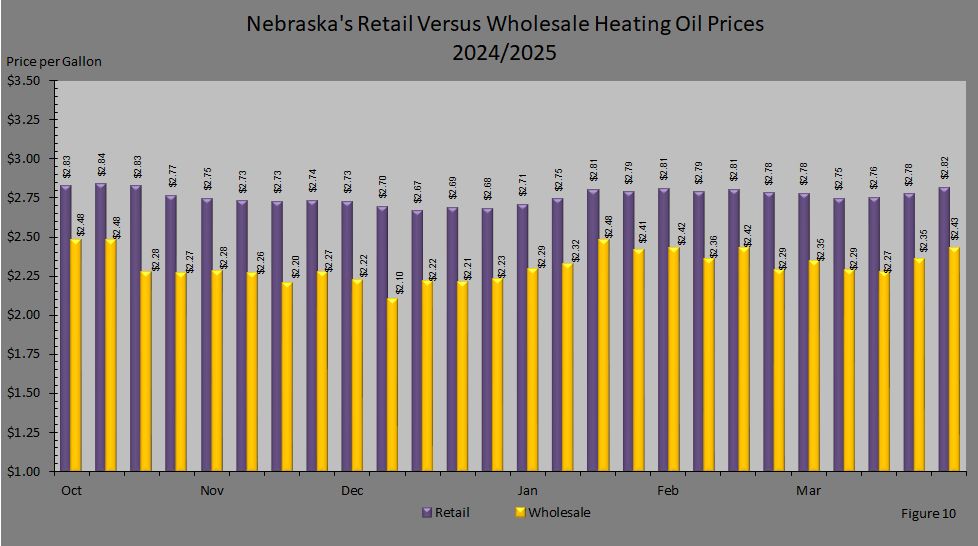
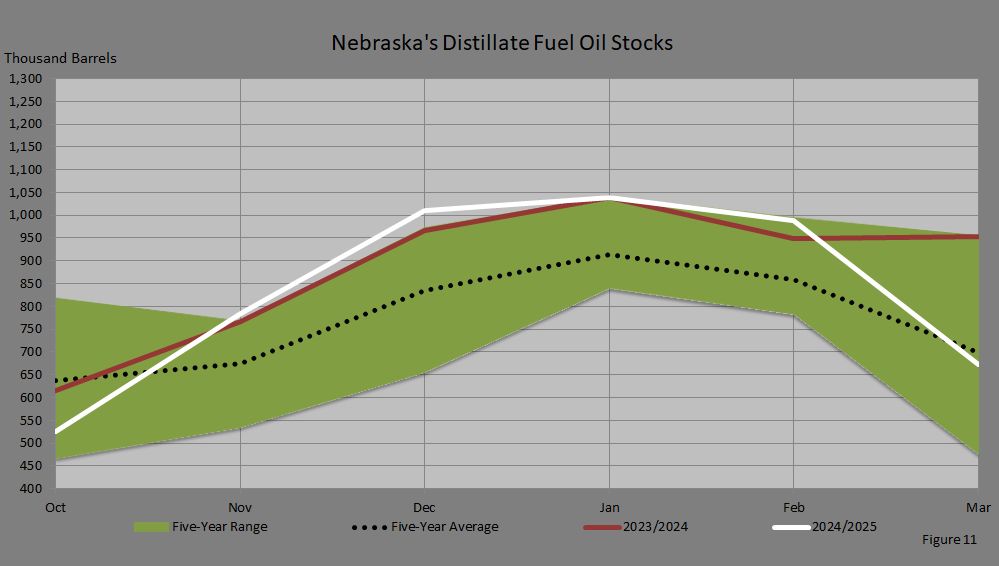
According to EIA, Nebraska's total inventory of distillate fuel was 525,000 barrels at the beginning of the heating season in October 2024, which was 91,000 barrels (15 percent) below distillate fuel stocks one year earlier.
Stocks started the season in the lower half of the five-year range but steadily increased to above the five-year range in November and December. In January and February, stocks remained at the upper boundary of the five-year range. The winter ended with stocks in the center of the five-year range at 672,000 barrels.
Stocks were below the five-year average in October and March--the beginning and the end of the season. For the rest of the heating season, stocks were above the five-year average. (Figure 11) (Right-click and choose "Open image in new tab".)
Heating Degree Days
The 2024/2025 winter heating season, as a whole, saw warmer-than-normal winter weather. The traditional heating season for both heating oil and propane is October through March. For this period, Nebraska normally has 5461 heating degree days. From October through March during the 2024/2025 winter season, Nebraska had 5107 heating degree days which indicates the weather was 6.5 percent warmer than normal. A degree day is a 1 degree Fahrenheit difference between 65 degrees Fahrenheit and the average outdoor air temperature on a given day. The more extreme the temperature, the higher the number of degree days. The higher the number of heating degree days, the colder the weather, and the more days that Nebraskans had to heat their homes.
Looking at individual months, it was warmer-than-normal winter weather from October through December, colder-than-normal winter weather in January and February, and then warmer-than-normal winter weather in March as reflected by Figure 1 (right-click and choose "Open image in new tab"). The bars in Figure 1 represent the heating degree day results of normal winter weather for each month in Nebraska. The line represents the heating degree day results of the actual weather that the 2024/2025 winter season experienced.
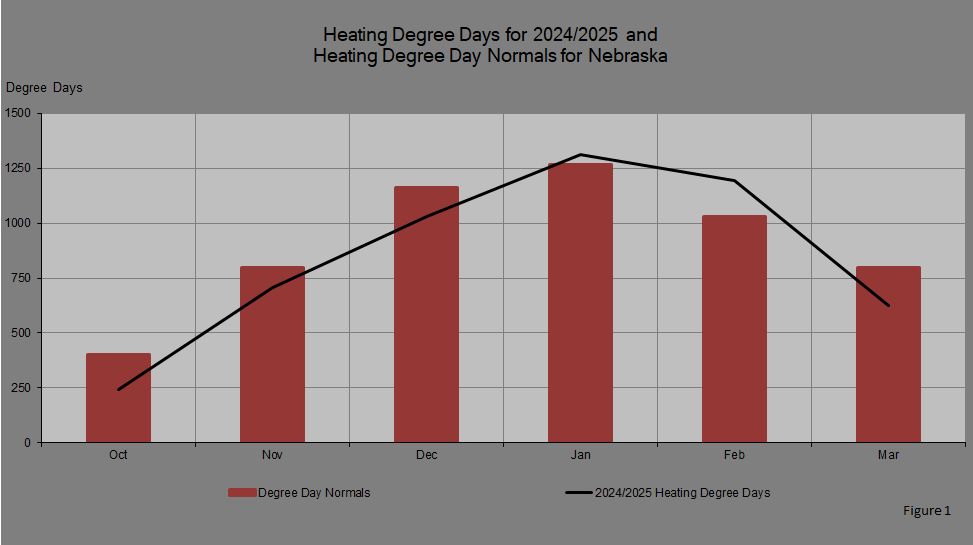
Purpose of State Heating Oil and Propane Program Survey
The Nebraska Department of Water, Energy, and Environment (DWEE) collects residential prices of No. 2 heating oil and consumer-grade propane in Nebraska during the heating season (October to March) for the State Heating Oil and Propane Program (SHOPP). It is the only U.S. Department of Energy (USDOE) Energy Information Administration (EIA) survey that collects propane prices. The data are used by DWEE to monitor Nebraska's propane prices and heating oil prices during the winter season to maintain awareness of any price or supply irregularities that may be developing. The data are also used by policymakers, industry analysts, and consumers.
Sources:
Today in Energy, U.S. Energy Information Administration, Washington, DC. https://www.eia.gov/todayinenergy/
Short-Term Energy Outlook, U.S. Energy Information Administration, Washington, DC. https://www.eia.gov/outlooks/steo/
2024/25 Winter Propane Market Update, U.S. Energy Information Administration, Washington, DC. https://www.eia.gov/special/heatingfuels/resources/Propane_Briefing.pdf
This Week in Petroleum, U.S. Energy Information Administration, Washington, DC. https://www.eia.gov/petroleum/weekly/
The Wall Street Journal (2024 October 2). Saudi Minister Warns of $50 Oil as OPEC+ Members Flout Production Curbs. Retrieved October 2, 2024, from https://www.wsj.com/business/energy-oil/saudi-minister-warns-of-50-oil-as-opec-members-flout-production-curbs-216dc070
AP News (2024 October 3). Dockworkers' union to suspend strike until Jan. 15 allow time to negotiate new contract. Retrieved October 4, 2024, from https://apnews.com/article/longshoremen-strike-ports-dockworkers-agreement-86fac07d1189e11ca4816b2cbf37affb
The Wall Street Journal (2024 October 3). Oil Surges After Biden Says U.S. Discussing Israel Attack on Iran Facilities. Retrieved October 4, 2024, from https://www.wsj.com/finance/commodities-futures/oil-surges-after-biden-says-u-s-discussing-israel-attack-on-iran-facilities-a59bc990
The Wall Street Journal (2024 October 28). Oil Prices Slide After Israeli Strike Avoids Iranian Energy Facilities. Retrieved October 28, 2024, from https://www.wsj.com/finance/commodities-futures/global-stocks-markets-dow-news-10-28-2024-8dfe4cd5?mod=Searchresults&pos=4&page=1
Nebraska Average Residential Propane Prices, Nebraska Department of Water, Energy, and Environment, Lincoln, NE. https://dee.nebraska.gov/state-energy-information/energy-statistics/fuels/propane/nebraska-residential-propane-prices
Nebraska Average Wholesale Propane Prices, Nebraska Department of Water, Energy, and Environment, Lincoln, NE. https://dee.nebraska.gov/state-energy-information/energy-statistics/fuels/propane/average-wholesale-propane-prices-nebraska
Nebraska Average Residential Heating Oil Prices, Nebraska Department of Water, Energy, and Environment, Lincoln, NE. https://dee.nebraska.gov/state-energy-information/energy-statistics/fuels/heating-oil/average-residential-heating-oil-prices-nebraska
Nebraska Average Wholesale Heating Oil Prices, Nebraska Department of Water, Energy, and Environment, Lincoln, NE. https://dee.nebraska.gov/state-energy-information/energy-statistics/fuels/heating-oil/wholesale-heating-oil-prices
This report was completed in September 2025.
| Attachment | Size |
|---|---|
| 2023/2024 SHOPP | 691.94 KB |
